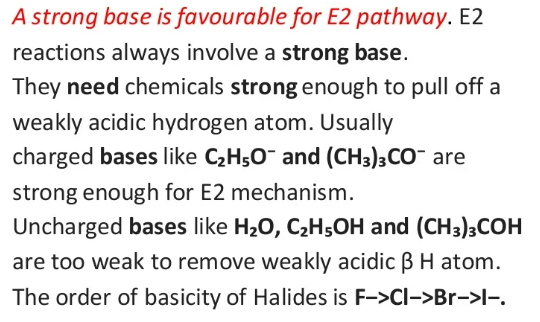A strong base is favourable for E2 pathway. E2 reactions always involve a strong base. They need chemicals strong enough to pull off a weakly acidic hydrogen atom. Usually charged bases like C₂H5O- and (CH3)3CO are strong enough for E2 mechanism. Uncharged bases like H₂O, C₂H5OH and (CH3)3COH are too weak to remove weakly acidic ß H atom. The order of basicity of Halides is F->CI->Br->I-.
Reactive Intermediates
In chemistry, reactive intermediates are termed as short-lived, highly reactive atoms with high energy. They rapidly transform into stable particles during a chemical reaction. In specific cases, by means of matrix isolation and at low-temperature reactive intermediates can be isolated.
Hydride Shift
A hydride shift is a rearrangement of a hydrogen atom in a carbocation that occurs to make the molecule more stable. In organic chemistry, rearrangement of the carbocation is very easily seen. This rearrangement can be because of the movement of a carbocation to attain stability in the compound. Such structural reorganization movement is called a shift within molecules. After the shifting of carbocation over the different carbon then they form structural isomers of the previous existing molecule.
Vinylic Carbocation
A carbocation where the positive charge is on the alkene carbon is known as the vinyl carbocation or vinyl cation. The empirical formula for vinyl cation is C2H3+. In the vinyl carbocation, the positive charge is on the carbon atom with the double bond therefore it is sp hybridized. It is known to be a part of various reactions, for example, electrophilic addition of alkynes and solvolysis as well. It plays the role of a reactive intermediate in these reactions.
Cycloheptatrienyl Cation
It is an aromatic carbocation having a general formula, [C7 H7]+. It is also known as the aromatic tropylium ion. Its name is derived from the molecule tropine, which is a seven membered carbon atom ring. Cycloheptatriene or tropylidene was first synthesized from tropine.
Stability of Vinyl Carbocation
Carbocations are positively charged carbon atoms. It is also known as a carbonium ion.
propan-1-ol → propene + water
C₃H₈O (l) → C3H6 (g) + H2O (l)
is considered an Elimination E2 reaction. An E2 Elimination is apparently where an external base is added, so the rate law should be rate = k[C₃H₈O][Base] however the rate law I have is only = k[C₃H₈O].
However, in this reaction, it seems no bases are involved because the catalyst being used is sulfuric acid, which is definitely not a base. Can someone help me with what I am missing here?
What factors affect the rate of E2 elimination? Some say that one factor is a strong attacking base -- which I do not think I have.
Please help!! I am so very lost

Step by step
Solved in 3 steps with 2 images


